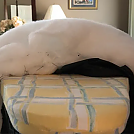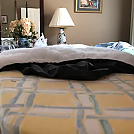I have the old original war bonnet yeti which was made up of removable layers of Climashield.
There was a huge differential between the inner layer and the outer layer. Then, single layers of 2.5 ounce per square yard Climashield were sewn to the inner shell on the outer edge. Or, at least the first, and only permanent, layer, was sewn around the perimeter of inside shell. There was even a differential built into each layer. When I added a layer, if memory serves, I was supposed to attache(quilt/sew) the edge of each new layer about 3/4"(?) inside the curve of the outer edge of the 1st layer. This was to adjust not just for the outer shell, to keep it from smashing the loft of the insulation. But to adjust as the loft kept getting thicker and further away from the user, the outside circle is bigger, like running on each lane further to the outside of a track has to be staggered so that the outside runner is not running an unfair distance. Adding the layers this way left a bunch of loose wrinkles when the UQ was laying flat. But this all pulled tighter and just snug enough when curved around a back and hammock. What a brilliant design!
So, if attaching the edge of the outside layer of Climashield to the same position on the shell edge as the inside layer, when the UQ is curved snugly around my back, it will end up being pulled tighter and lose some of it's loft.
But, I think I figured out a better way to handle that when I add a layer back. I wrap the inside out UQ around an ironing board, which puts a curve into the UQ similar to it being curved around my back when I'm in the hammock. Then I just lay the new layers on top so that there is no tension on them, and quilt the outer edge at the point where it lands. Then I can pull the quilt very snug against my back with no compression of layers. Seems to work.
The outer layer is actually a lot more than just a differential cut, since in this case all insulation layers are either sewn to the innner shell, or just to the other layers of insulation. So, ther is no down which needs to loft up towards the inner shell, filling some chambers. Thus, the outer shell hangs loose enough below the outermost layer of insulation that I can stuff a down vest or other clothing in there, between the CS and the outer shell. Resulting in truly awesome loft. I always thought this UQ design was one of the best any one ever came up with.
But, on the subject of dif cuts for synthetic UQs: yes, I think it is needed if I expect to get the max out of the synthetic insulation. No benefit to crushing the loft.
Bill
curved around an iron board 1 permanent layer of Climashield installed, about to add other layers:
.................................................. .......
3 more layers added:







 Reply With Quote
Reply With Quote

Bookmarks